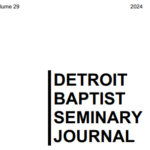Do You Know Any Heretics?
 Within American history the names of Benedict Arnold, Aaron Burr, and the Rosenbergs live on in infamy. These are people who rather notoriously tried to undermine the well-being of our nation for some kind of personal profit. We look back on such individuals with a mixture of interest and disdain. How could they do such things? How could they betray our country? Yet, the Christian church has had its share of notorious traitors or heretics as well.
Within American history the names of Benedict Arnold, Aaron Burr, and the Rosenbergs live on in infamy. These are people who rather notoriously tried to undermine the well-being of our nation for some kind of personal profit. We look back on such individuals with a mixture of interest and disdain. How could they do such things? How could they betray our country? Yet, the Christian church has had its share of notorious traitors or heretics as well.
What a man like Benedict Arnold is to American history, men like Arius and Pelagius are to church history. One might think that such heretics should be avoided at all costs, and in a sense, they should be. At least, their teachings should be soundly rejected by all those who profess Christ. But it is difficult to reject a teaching you have never encountered. And if one does not know where some professing “Christians” have gone astray in the past, one might begin wandering down a similar path in the present.
 I recently came across a fascinating little book by Justin Holcomb, titled Know the Heretics (Zondervan, April 2014). In fewer than 180 pages, the author provides a concise and helpful introduction to some of the more notorious heretics in the history of the church. Divided into twelve short chapters, Holcomb introduces his readers to groups like the Judaizers and the Gnostics and to individuals like Sabellius and Socinus (the only post-Reformation character included). Each chapter is divided into four sections: Historical Background, Heretical Teaching, Orthodox Response, and Contemporary Relevance. That last section—Contemporary Relevance—is especially interesting. In many of the chapters, Holcomb points out that the error in question is still alive and well today. For example, he speculates that many otherwise orthodox Christians would probably describe the incarnation of Christ in terms that bear a strong resemblance to Apollinarianism (pp. 105–6). And he notes that the teachings of Socinus are still echoing within the walls of most Unitarian churches today (p. 152). Unfortunately, even the most egregious theological errors rarely disappear forever.
I recently came across a fascinating little book by Justin Holcomb, titled Know the Heretics (Zondervan, April 2014). In fewer than 180 pages, the author provides a concise and helpful introduction to some of the more notorious heretics in the history of the church. Divided into twelve short chapters, Holcomb introduces his readers to groups like the Judaizers and the Gnostics and to individuals like Sabellius and Socinus (the only post-Reformation character included). Each chapter is divided into four sections: Historical Background, Heretical Teaching, Orthodox Response, and Contemporary Relevance. That last section—Contemporary Relevance—is especially interesting. In many of the chapters, Holcomb points out that the error in question is still alive and well today. For example, he speculates that many otherwise orthodox Christians would probably describe the incarnation of Christ in terms that bear a strong resemblance to Apollinarianism (pp. 105–6). And he notes that the teachings of Socinus are still echoing within the walls of most Unitarian churches today (p. 152). Unfortunately, even the most egregious theological errors rarely disappear forever.
Holcomb’s book doesn’t plow any new ground, and it’s not intended to. But it does provide a good introduction to some of the more important false teachers in the history of the church. And studying such characters provides both a warning and a helpful perspective on the state of the church today. As G. K. Chesterton once said, “The disadvantage of men not knowing the past is that they do not know the present. History is a hill or high point of vantage, from which alone men see the town in which they live or the age in which they are living” (Chesterton, “On St. George Revivified”).



Love the Chesterton quote.